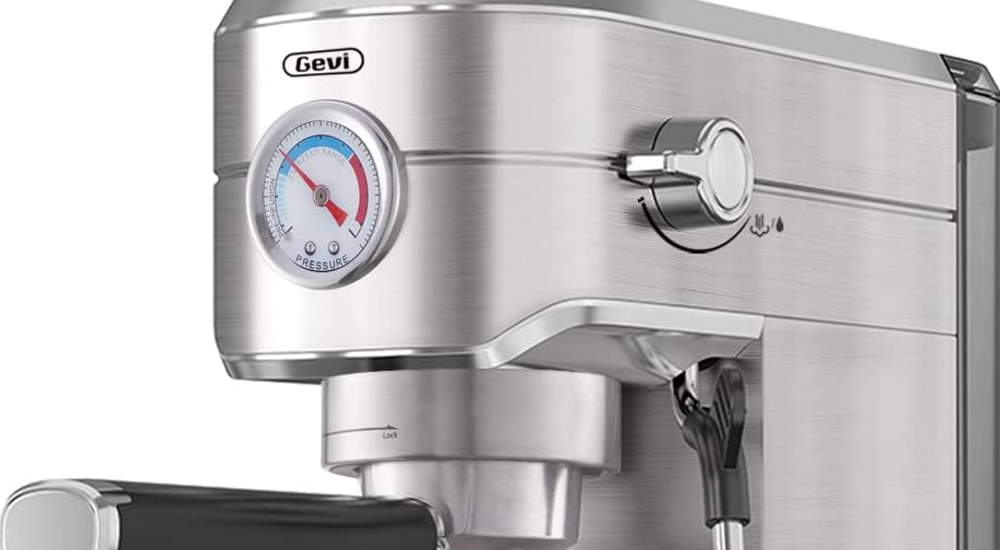Gevi brand provides one of the best coffee machines available on the market, especially for the low price. We are going to compare 15 Bar vs 20 Bar Gevi Espresso machine models and write a review of each. If you’re looking for a good espresso machine, for a decent price here comes a shortlist of our recommendations.
The Gevi Espresso Machine is a great pick for coffee junkies. While both its espresso-making and milk-steaming abilities are good, we can’t say they can quite match the quality you’d get at a coffee shop. These Gevi machines are great for small kitchen stands and they’ll make cafe-quality espresso as well as cappuccinos and lattes. Furthermore, at a price like these are sold, you’ll get a great deal for your home! Let us write about a few 15 Bar and 20 Bar Gevi Espresso Machines in the text that follows.
The main difference between 15-bar and 20-bar espresso is the amount of pressure used to extract the espresso shot. 15 bar espresso is extracted using 1.5 bars of pressure, while 20 bar espresso is extracted using 2 bars of pressure. The higher pressure used for 20-bar espresso results in a more concentrated, bolder flavor, with a thicker crema on top.
What is the difference?
The taste of the coffee produced by a 15-bar vs. 20-bar coffee machine may differ slightly, but it is not always easy to discern a significant difference between the two.
The bar (pressure) rating of an espresso machine refers to the pressure at which water is forced through the coffee grounds to extract the flavor and oils. A higher pressure can lead to a more intense extraction and crema, while a lower pressure can result in a lighter, less intense flavor.
A 15-bar machine is considered the standard pressure for most home espresso machines, while a 20-bar machine is generally associated with higher-end, commercial-grade machines. However, the quality of the coffee produced is determined by several factors, including the freshness of the beans, the grind size, and the tamping pressure.
Therefore, the taste difference between a 15-bar and a 20-bar machine is likely to be subtle and depend on the specific machine and brewing method used. It is important to note that a higher pressure does not necessarily equate to better taste and that factors such as bean quality and preparation method play a significant role in the taste of the final product.
15 & 20 Bar – Gevi Espresso Machine Review
First of all, why choose between 15 and 20-bar espresso machines? These are known as the most powerful for quality aroma extraction. With a pump powerful enough to achieve that pressure, you’ll enjoy the coffee taste and aroma as you do in the coffee shop.
15 bar espresso is generally considered to be the ideal pressure for espresso extraction. It is generally recommended for producing a balanced shot with a nice crema. 20-bar espresso is not necessarily better, but it can produce a more intense flavor profile with more crema. A 20-bar espresso machine is good. It is more than capable of making good-quality espresso and other espresso-based drinks. If you are looking for an espresso machine that is capable of making great espresso, then a 20-bar machine is a good choice.
Gevi 15 Bar Espresso Machine Reviews
Gevi Espresso Machine 5403 with a 15 Bar Pump
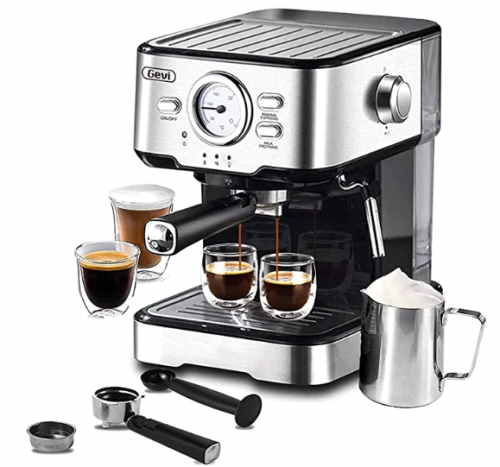
With this model you’ll get a 15-bar pressure pump that ensures the coffee flavors, maintaining the aroma of the coffee. Gevi 5403 Expresso Coffee Machine reaches the optimal brewing temperature quickly and keeps the coffee at a perfect temperature.
We like the most: 15-Bar is the standard pressure to brew rich-tasting espresso, to ensure the best coffee flavors and full aroma.
Gevi Espresso Machine 5003D with a 15 Bar Pump
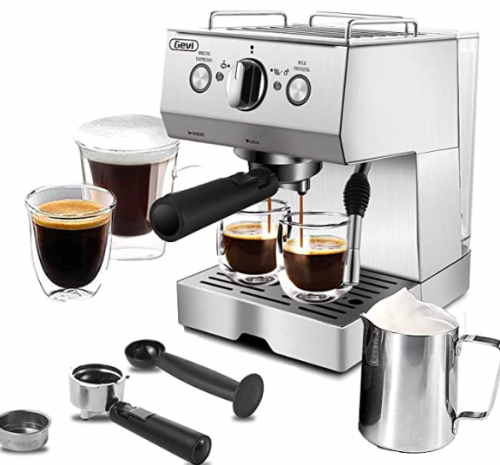
Another Gevi model that has a 15 Bar pressure pump makes sure that you’ll get the best coffee flavors. It maintains the aroma of the coffee. Expresso Coffee Machine 5003D maintains the optimal brewing temperature for the best coffee makers with a perfect temperature.
We like the most: Double Espresso Shots – 2 in 1 Portafilter makes 2 cups of espresso at once.
Gevi 20 Bar Espresso Machine Reviews
Gevi Espresso Machine 5400 with a 20 Bar Pump
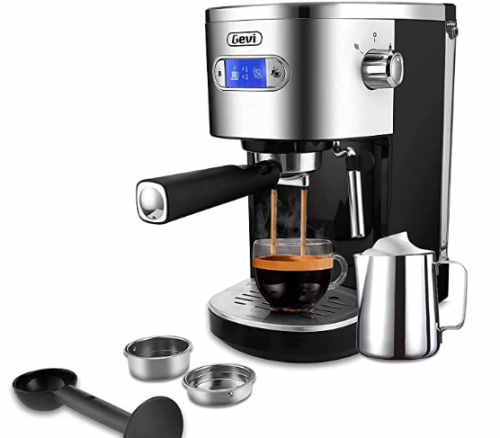
Gevi 20 bar thermo-block espresso machine only needs 25-45s to finish a cup of espresso. With its stainless steel finishes, this powerful machine looks great in any kitchen and will enhance your entire espresso, cappuccino, and latte experience.
We like the most:
- 20 Bar Pressure System
- 2-in-1 Espresso Machine
- LED Screen Display
Gevi Espresso Machine 5022 with a 20 Bar Pump
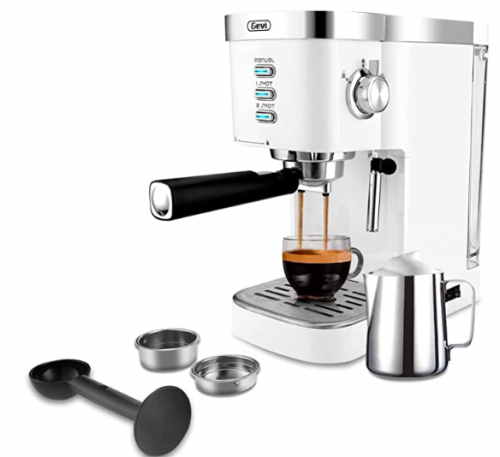
Gevi 20 Bar high-pressure coffee maker for the best coffee extraction and aroma.
We like the most:
- You can choose One shot, Double shots, or Manual-Control the amount of coffee by yourself.
- Enjoy making a good coffee in just about 45 seconds.
- With a 20-bar high-pressure pump, you’ll get fast and stable extraction that makes espresso more fragrant and rich in crema.
Pump-driven espresso machines
If compare to steam-driven espresso machines, pump-driven espresso machines are significantly more efficient. Furthermore, they yield better espresso in most cases. To make the pressure, these coffee makers use a pressure pump.
The pressure pump pushes hot water forcefully into and through the grounds. That’s the point where the magic happens, and all the taste and aroma extract into a coffee cup.
Because of their superior quality, pump-driven coffee makers are more expensive than steam-driven machines.
Gevi coffee maker 15 and 20 bar pressure pump
A 15-bar espresso machine can at most, force heated water through the coffee at 15x the present atmospheric pressure of the earth.
A 20-bar espresso machine should technically be capable of forcing heated water through the coffee at up to 20x the present atmospheric pressure of the earth.
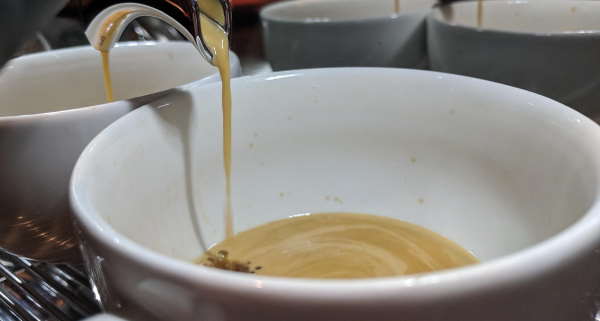
A bar is a metric unit. 1 bar is approximately equal to atmospheric pressure at sea level. So when we talk about an espresso maker using 15 bars, or 20 bars, the water is forced through the system at that pressure. However, 7-9 bar pressure is present at the “sweet spot”. That’s what we call the spot where water extracts aroma and taste from the coffee grounds at a pressure.
The higher the pressure, the faster the coffee is extracted from the grounds. So in theory, you could get a quicker cup of coffee if you just amped up the pressure. But there’s a reason that the suggested extraction time for espresso is between 25-30 seconds.
It’s the balance of all these elements that counts. But taking into consideration all the other things that create a good espresso, nine bars have been found to be the sweet spot.
Ease of Cleaning Gevi Espresso Machine
Before going to the end, to make this Gevi review worth your time, let’s write a few words about cleaning these coffee machines. The cleaning process for these machines is fairly standard. You need to keep the water tray clean and dry, the steam wand wipes down easily, and the descaling process is relatively hands-off. Make sure to clean the portafilter as you should. That way you’ll get the best coffee aroma each time you wish for.
Conclusion
Gevi produces quite good coffee machines for a reasonable price. You’ll enjoy a good espresso or cappuccino at a very low price, in your own home. Keep in mind that you’ll need a grinder. Neither of these Gevi coffee makers comes with a grinder installed. The Gevi provides slightly above-average performance in general, and all that for a far below-average price. Both, 15 bar and 20-bar coffee makers are good. You choose the best model for your own needs and preferences.
Check for Double wall insulated glasses espresso mugs also.
The best water pressure for a coffee machine depends on the type of machine and the brewing method being used.
For most home espresso machines, a pressure of 9 to 15 bars is recommended for optimal extraction. This pressure range is sufficient to extract the flavors and oils from the coffee beans without over-extracting or under-extracting, which can result in a bitter or weak-tasting espresso.
For drip coffee makers, the recommended water pressure is between 1 and 2 bars. This lower pressure is adequate for brewing coffee in larger quantities and does not require the high pressure used in espresso machines.
It is important to note that the water temperature and quality also play a crucial role in the taste of coffee, and the ideal pressure may vary depending on the specific brewing method and coffee beans being used. Therefore, it is best to refer to the manufacturer’s recommendations and experiment with different settings to find the ideal pressure for your coffee machine.
